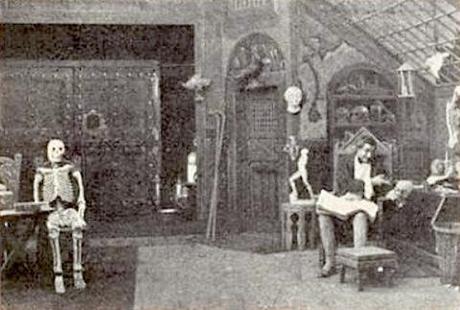
by Steve Habrat
Contrary to popular belief, James Whale’s legendary 1931 Boris Karloff vehicle Frankenstein was not the first interpretation of Mary Shelley’s classic novel. In 1910, Edison Studios released J. Searle Dawley’s eerie short Frankenstein, a primitive little horror film that is surprisingly morbid considering the time it was made. At a brief twelve minutes, Dawley’s Frankenstein bursts with gothic images and morbid effects that would have certainly made magician-filmmaker George Méliès proud and had naïve audience members cowering in a ball under their chairs. This impressive little short does suffer from some disrupting over-acting, a typical staple for early silent films such as these, but this early version of Frankenstein does feature a grotesquely memorable monster that commands each and every scene that he lumbers into.
We’re all familiar with the story of Frankenstein, so I won’t bore you to death with a plot synopsis. Dawley’s film condenses much of Shelley’s original story, but the film is surprisingly complete given the brief runtime and small cast. The morality tale is firmly in place, but it doesn’t play as prominent a role as it did in Whale’s symbolic classic or the heavy-handed follow-up The Bride of Frankenstein. We’re still warned not to play God, and any attempt to do so could destroy our lives and drive us to the brink of madness.
The highlight of Dawley’s Frankenstein is easily the creation sequence, a scene that finds the Frankenstein monster growing from a bubbling cauldron of various liquids mixed together. After a sudden plume of smoke that certainly made audiences gasp with wonder, a charred skeleton begins to emerge, slowly covering itself with rotten organs, muscle, and flesh. As all of this occurs, the creature waves its arms wildly around the screen, a simple act that terrifies the young Frankenstein enough to lock his creation behind big heavy doors. Naturally, this doesn’t keep the monster out, but it doesn’t take long for an undead arm to burst through the barrier and reach out at the skittish young doctor. There is no doubt in my mind that this sequence drove many audience members from the theater, screaming in horror at this abomination of science. And they had barely caught a glimpse of the monster in all its finished glory.

While the performances from Augustus Phillips and Mary Fuller are largely just exaggerated demonstrations of affection or heart-stopping terror, the standout is Charles Ogle as the monster. Hidden behind grainy camerawork and gobs of misshapen make-up, this shaggy beast tiptoes into each frame, stretching out his arms and reaching for his maker like a deformed infant. He resembles a goblin that has been hiding out in the wilderness for a year, a far throw from Karloff’s bolted and stitched appearance, but he is still effective in his own way. Especially devastating is the scene in which he glimpses himself in the mirror, gaping in horror as he realizes that he is indeed a hideous creation born of chemical mixtures. Even more interesting is the psychological twist that is put on Ogle’s monster, molding him into a physical manifestation of the evil that lurks in the deepest depths of Frankenstein himself.
While Dawley’s Frankenstein may not enjoy the lavish budget that Whale’s Universal Studios effort did, there is still a haunting gothic mood that oozes out of each and every frame. Rather than resorting to crumbling castles, overgrown graveyards, lightning storms, and dead forests to set the mood, Dawley simply places a few skulls around the set, enough to give the sets a macabre punch. Plus, just the fact that the film is as old as it adds another unsettling layer to the proceedings. Overall, thought lost for many, many years, Dawley’s Frankenstein is a must-see fragment of cinema history. It’s astonishing to see what was being accomplished in the early days of the medium and there is an eeriness to it if watched in the dead of night with the slightly distracting score turned all the way down. Dawley’s Frankenstein is a must-see for any student of film or horror fan.
Grade: A-
Frankenstein is available on DVD.
Watch J. Searle Dawyley’s Frankenstein below:
Anti-Film School does not claim ownership of this video.
